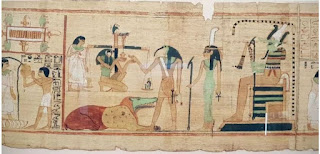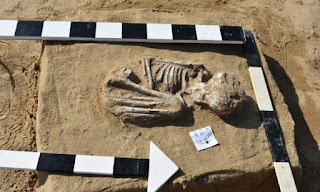World's Oldest Cheese: A 3,200 Years Old Cheese Found In An Egyptian Tomb
Scientists from the University of Catania and Cairo University found a solidified whitish mass in a jar, left in an Egyptian tomb. The substance turned out to be a 3,200 year old piece of cheese, among the oldest ever discovered.
A few years ago a team of archaeologists cleaning sand from an ancient Egyptian tomb discovered a group of broken jars, one of them containing a mysterious white substance. The team had guesses as to what the material might be, but a new analysis published in the journal Analytical Chemistry offers an answer: what they found during that excavation was an approximately 3,200 year old piece of cheese, one of the oldest solid specimens discovered
Found: Surprisingly Modern Paint on an Ancient Egyptian Gate
How did a pigment that Vermeer used in the 1600s wind up on Egyptian art from the 6th century BC?
THE PHARAOH APRIES WAS NOT exactly popular. He lost his kingdom to someone who, according to Herodotus, once farted in his face, and in 570 BC was strangled by the Egyptians he once ruled. But he had an excellent palace. Built in the northern part of the ancient Egyptian city of Memphis, Apries’s palace was a sprawling 524 feet by 354 feet. The Pharaoh would enter the grounds through an enormous gate decorated with seven limestone reliefs, one of which depicted the pharaoh under a star-filled blue sky. Other scenes have been lost to time.
Egyptian sculpture about 2686 BC – AD 396
Travel back through 3,000 years of Egyptian history and come face-to-face with the Rosetta Stone and the Statue of Ramesses II.
The objects in the Egyptian sculpture gallery represent three millennia of pharaonic history. The displays have evolved with the field of Egyptology itself.
Modern Egyptology began with a French scientific expedition accompanying Napoleon's invasion of Egypt in 1798. After the British defeated the French, they took some of their most important finds, including the Rosetta Stone and the sarcophagus of the last Egyptian pharaoh, both displayed here.
A German Museum Tried To Hide This Stunning 3D Scan of an Iconic Egyptian Artifact. Today You Can See It for the First Time
After a three-year freedom of information campaign, everyone can finally see the Egyptian Museum of Berlin’s official scan of the Bust of Nefertiti.
For more than a decade, museums around the world have been making high-quality 3D scans of important sculptures and ancient artifacts. Some institutions, such as the Smithsonian and the National Gallery of Denmark, have forward-thinking programs that freely share their 3D scans with the public, allowing us to view, copy, adapt, and experiment with the underlying works in ways that have never before been possible. But many institutions keep their scans out of public view.
Archaeology Breakthrough: Scientists Unravel Major Discovery that Redefines Ancient Life
Image: AFP
SCIENTISTS have used advanced technology to scan the bones of ancient humans in an attempt to understand their daily lives.
The experts utilised modern technology to shine a light on what daily life was like in ancient Egypt in a never before seen study. Using lasers, X-rays and infrared tools, scientists have been able to scrutinise and examine the bones of mummies to better understand our ancestors.
Ancient Egyptians Sacrificed and Mummified Millions of These Sacred Birds—Here's How They Gathered So Many
WASEF ET AL, 2019
The ancient catacombs of Egypt contain millions of mummified birds of the species Threskiornis aethiopicus—better known as the African sacred ibis. Now researchers have cast new light on how the Egyptians obtained so many of these animals—something that has long puzzled experts.
The Egyptians commonly sacrificed and mummified these birds between 665 B.C. and 250 A.D. in honor of the god Toth—who was often depicted as a man with the head of an ibis.
Photos: 3,400-Year-Old Tomb Along Nile River
(Image credit: AcrossBorders project/Julia Budka)
A tomb dating back around 3,400 years has been discovered on Sai Island, on the Nile River in Sudan. The tomb has multiple burial chambers, which contain the remains of more than a dozen, possibly mummified, individuals. The tomb was constructed at a time when there was an Egyptian settlement and gold mine on the island. This picture shows some of the artifacts found in the tomb, including a stone shabti, meant to do the work of the deceased in the afterlife.
Egyptian Museum opens in Rio Grande do Sul
Egyptian artist and businessman Essam Elbattal established in Canela in the Serra Gaúcha a museum with a pharaonic setting of Ancient Egypt. Venue features an internal pyramid with sarcophagus and hieroglyphs. Visitors may dress up in tunics, wigs and turbans.
Canela’s Egyptian Museum comprises a 3,000-square-meter plot and over 1,200 square meters of building area, with sculptures, busts, pieces, and mortuary chambers that refer to the history of the great pharaohs, queens and figures of Ancient Egypt, including Tutankhamun, Ramesses II, Akhenaton, Cleopatra, and Nefertiti.
Egypt Discovery: Historian's Stunned Reaction to 'Oldest Tomb of His Career' Revealed
Image: CHANNEL 5
The discovery came after Tony Robinson joined archaeologist Dr Vasko Dobrev who had uncovered more than 60 tombs in his quest to find the missing Pharaoh Userkare, who he believes is buried in an unfinished pyramid below Saqqara. The suspected burial site served as the necropolis for the Ancient Egyptian capital of Memphis and is home to numerous other pyramids including the Step Pyramid of Djoser. Dr Dobrev has spent the last three decades probing the area just 19 miles from the world-famous Giza Plateau and he now thinks he is closer to hitting the jackpot.
New Discoveries in Egyptology (September-October 2019)
Photo: Ahram
Every two months, the Nile Scribes bring you summaries of the latest research and discoveries in Egyptology, both from the field and the archives. We introduce you to the newest archaeological finds or rediscovered artefacts from museum collections, plus other new theories stirring in the Egyptological Zeitgeist. While few excavations take place in Egypt during the heat of the summer, there has nevertheless been a number of exciting discoveries announced at the outset of the cooler, post-summer months. The world’s attention was recently captured by the discovery of a new cache of Twenty-Second Dynasty mummies at Asasif in Luxor.
A Nile Journey Into the Past
Credit...Boyer/Roger Viollet, via Getty Image
In the 19th century, women explorers sailed the Nile, sending back vivid accounts of Egypt’s riches. A 21st-century writer travels in their wake.
Huddled on a chaise on the upper deck of the Orient, the dahabiya that I had chosen for a cruise down the Nile, I sipped hibiscus tea to ward off the chill. Late in February, it was just 52 degrees in Aswan, where I had boarded the sailboat, but the scenery slipping past was everything the guidebooks had promised: tall sandbanks, curved palms and the mutable, gray-green river, the spine of Egypt and the throughline in its history.
‘Ancient Wonders’ With a Future
PHOTOGRAPHS BY DEAN KEEFER
The Museum of Ancient Wonders opens in Cathedral City with replicas of King Tutankhamun artifacts, African masks, and prehistoric fossils.
A modest strip mall at the corner of Highway 111 and Date Palm Drive is an unlikely place for King Tutankhamun’s golden chariot and the skull of a T-Rex, but Alberto Acosta and Joe McCabe are making it work. The Museum of Ancient Wonders, the Coachella Valley’s newest cultural attraction, opened Oct. 26, showing a portion of Acosta’s extensive collection of replicas of Egyptian antiquities and dinosaur fossils, along with artistic recreations of African masks representing 3,500 years of tribal ritual and mysticism.
Ancient Greek and Roman Cemetery Discovered in Egypt
Credit: ET
The Egyptian Ministry of Antiquities announced recently that an ancient Greek and Roman cemetery has been discovered in Ismailia.
According to reports, the cemetery has multiple levels. The upper levels date back to ancient Greek and Roman times, while the lower are from Egypt’s pre-dynastic eras.
Egypt Says It’s Unearthed Large Animal Mummy, Likely a Lion
Egypt’s Ministry of Antiquities says local archeologists have unearthed the mummy of an unusually large animal, most likely a lion or lioness. The ministry said on Monday the mummy was excavated in Saqqara, a town south of Cairo that was a vast necropolis in antiquity and is home to the famed Step Pyramid.
Here's a more comprehensive article from NBC that came with this photo. This mummified lion was found in the tomb on King Tut's wet nurse. The colored scale has been placed next to it for measurement purposes.
P. Chapuis / MAFB. Copyright Hypogees
Ahnaten at the Met Trailer
Reviews:

















No comments:
Post a Comment
Note: Only a member of this blog may post a comment.